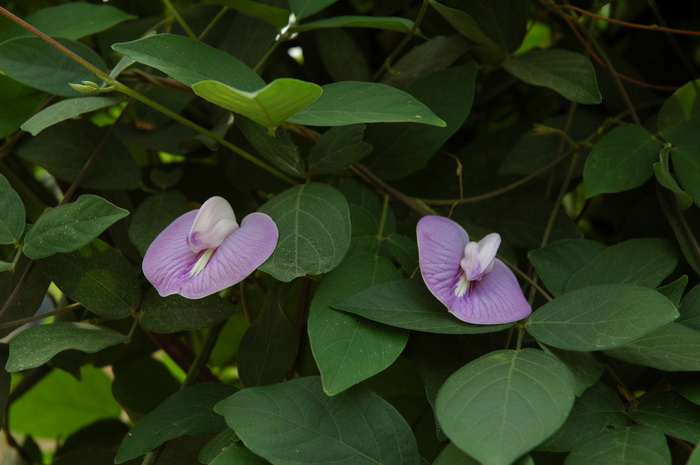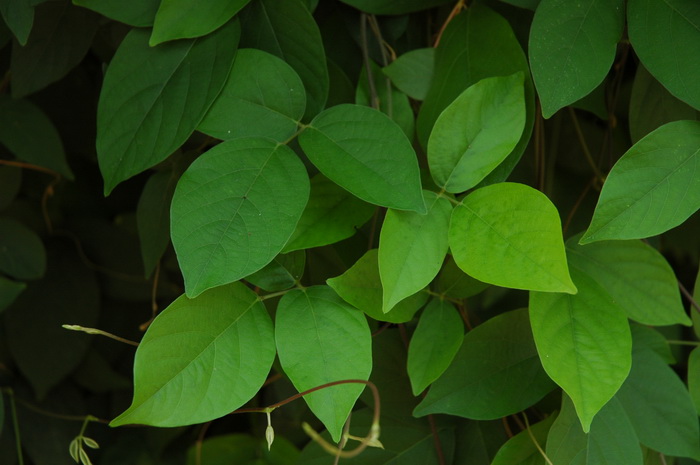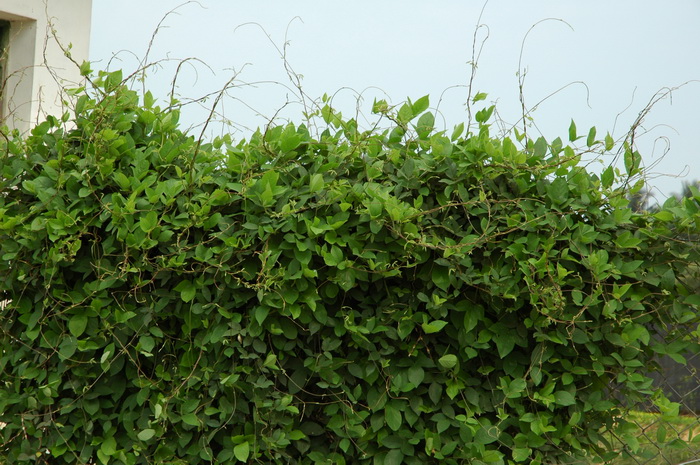距瓣豆Centrosema pubescens
中文名(Chinese Name):距瓣豆
学名(Scientific Name):Centrosema pubescens Benth.
英文名(English Common Name):flor de conchitas
别名(Chinese Common Name):
异名(Synonym):Centrosema salzmannii Benth. Clitoria grandiflora M. Martens et Galeotti Centrosema intermedium A. Rich. Centrosema molle Mart. ex Benth. Clitoria shiedeana Schltdl. Bradburya pubescens (Benth.) Kuntze Clitoria schiedeana Schltdl. Centrosema ferrugineum A.Rich. Bradburya schiedeana (Schltdl.) Rose Centrosema schiedeanum (Schltdl.) R.J. Williams & R.J. Clem. Ternatea schiedeana (Schltdl.) Kuntze
科属(Family & Genus):蝶形花科,Fabaceae距瓣豆属
形态特征(Description):多年生草质藤本。各部分略被柔毛,茎纤细。叶具羽状3小叶;托叶卵形至卵状披针形,长2-3毫米,具纵纹,宿存;叶柄长2.5-6厘米;小叶薄纸质,顶生小叶椭圆形、长圆形或近卵形,长4-7厘米,宽2.5-5厘米,先端急尖或短渐尖,基部钝或圆,两面薄被柔毛;侧脉纤细,每边5-6条,近边缘处联结;侧生小叶略小,稍偏斜;小托叶小,刚毛状;小叶柄短,长约1-2毫米,但顶生1枚较长。总状花序腋生;总花梗长2.5-7厘米;苞片与托叶相仿;小苞片宽卵形至宽椭圆形,具明显线纹,与萼贴生,比苞片大;花2-4朵,常密集于花序顶部;花萼5齿裂,上部2枚多少合生,下部1枚最长,线形;花冠淡紫红色,长2-3厘米,旗瓣宽圆形,背面密被柔毛,近基部具一短距,翼瓣镰状倒卵形,一侧具下弯的耳,龙骨瓣宽而内弯,近半圆形,各瓣具短瓣柄;雄蕊二体。荚果线形,长7-13厘米,宽约5毫米,扁平,先端渐尖,具直而细长的喙,喙长10-15毫米,果瓣近背腹两缝线均凸起呈脊状;种子7-15颗,长椭圆形,无种阜,种脐小。花期11-12月。
分布(Distribution):原产热带美洲,我国华南、华东、西南等地引种栽培。
用途(Use):本种为优良绿肥和覆盖植物;茎叶可作饲料。稍耐阴。
引自植物志英文版:FOC Vol. 10 Page 202, 203
Centrosema pubescens Bentham, Comm. Legum. Gen. 55. 1837.
距瓣豆 ju ban dou | Fabaceae | Centrosema
Bradburya pubescens (Bentham) Kuntze; B. schiedeana (Schlechtendal) Rose; Centrosema ferrugineum A. Richard; C. intermedium A. Richard; C. molle Martius ex Bentham; C. salzmannii Bentham; C. schiedeanum (Schlechtendal) R. J. Williams & R. J. Clements; Clitoria schiedeana Schlechtendal; Ternatea schiedeana (Schlechtendal) Kuntze.
Herbs, perennial. Stems twining or trailing, sometimes rooting at nodes, slender, villous. Leaves pinnately 3-foliolate; stipules ovate to ovate-lanceolate, 2-3 mm, with longitudinal striations, persistent; petiole 2.5-6 cm; stipels small, setiform; petiolules short, 1-2 mm, terminal one longer; leaflets thinly papery, terminal leaflet elliptic, oblong, or subovate, 2.6-10 × 1.5-6.8 cm, sparsely villous on both surfaces, lateral veins 5-7 on each side, slender, merging near margin, base obtuse or rounded, apex acute; lateral leaflets slightly small, slightly oblique. Raceme with 2-4 flowers near apex; peduncle 2.5-7 cm; bracts similar to stipules in shape; bracteoles broadly ovate to broadly elliptic, obviously striate, adpressed to calyx, larger than bracts. Calyx 5-lobed; upper 2 lobes ± connate, lowest longest, linear. Corolla white, pink, or light purple, 2-3 cm; standard broadly orbicular, densely villous abaxially, with short spur near base; wings falcate-obovate, one side with curved auricle, almost semicircular, each petal shortly clawed. Legume linear, 7-13 × 0.5-0.6 cm, compressed, apex acuminate, beak straight, slender, 8-15 mm; valves convex to ridge from both sutures, twisting at dehiscence. Seeds 7-15, brownish black or yellowish green with dark mottling, oblong, 4-5 mm; hilum short. Fl. Nov-Apr, fr. Jan-Jul. 2n = 22.
Introduced forage plant; near sea level to 100 m. Guangdong, Hainan, Jiangsu, Taiwan, Yunnan [native to Central America (extending to 22° N in Mexico) and South America (Colombia)].
Fantz (Sida 17: 321-332. 1996) showed that the material widely used for herbage and as a green fertilizer by agronomists under the name Centrosema pubescens belongs to two distinct species: the majority to C. molle and the remainder to C. pubescens sensu stricto. However, because the identity of the available Chinese material is not clear, the name C. pubescens is used here in its old, inclusive sense. Wiersema and Kirkbride (Taxon 54: 209-210. 2005) proposed conservation of the name C. pubescens with a conserved type. If this proposal is successful, the correct name for the taxon currently known as C. pubescens sensu stricto will be C. schiedeanum, and that for C. molle will be C. pubescens. There is ongoing debate on the desirability of such a change, and it is possible that the name C. pubescens might instead be rejected to avoid confusion resulting from a change in its correct usage, in which case the name C. schiedeanum would again be correct, while C. molle would remain in use. The two species may be distinguished as follows: C. molle: bracts 4-6 × 1-2 mm, puberulous; pedicels 6-9 mm at anthesis; bracteoles 6-9 × 4-6 mm; seeds brownish black; C. pubescens: bracts 6-9 × 3-6 mm, sericeous; pedicels 3-6 mm at anthesis; bracteoles 10-16 × 6-9 mm; seeds yellowish green.


 (责任编辑:徐晔春)
(责任编辑:徐晔春)
学名(Scientific Name):Centrosema pubescens Benth.
英文名(English Common Name):flor de conchitas
别名(Chinese Common Name):
异名(Synonym):Centrosema salzmannii Benth. Clitoria grandiflora M. Martens et Galeotti Centrosema intermedium A. Rich. Centrosema molle Mart. ex Benth. Clitoria shiedeana Schltdl. Bradburya pubescens (Benth.) Kuntze Clitoria schiedeana Schltdl. Centrosema ferrugineum A.Rich. Bradburya schiedeana (Schltdl.) Rose Centrosema schiedeanum (Schltdl.) R.J. Williams & R.J. Clem. Ternatea schiedeana (Schltdl.) Kuntze
科属(Family & Genus):蝶形花科,Fabaceae距瓣豆属
形态特征(Description):多年生草质藤本。各部分略被柔毛,茎纤细。叶具羽状3小叶;托叶卵形至卵状披针形,长2-3毫米,具纵纹,宿存;叶柄长2.5-6厘米;小叶薄纸质,顶生小叶椭圆形、长圆形或近卵形,长4-7厘米,宽2.5-5厘米,先端急尖或短渐尖,基部钝或圆,两面薄被柔毛;侧脉纤细,每边5-6条,近边缘处联结;侧生小叶略小,稍偏斜;小托叶小,刚毛状;小叶柄短,长约1-2毫米,但顶生1枚较长。总状花序腋生;总花梗长2.5-7厘米;苞片与托叶相仿;小苞片宽卵形至宽椭圆形,具明显线纹,与萼贴生,比苞片大;花2-4朵,常密集于花序顶部;花萼5齿裂,上部2枚多少合生,下部1枚最长,线形;花冠淡紫红色,长2-3厘米,旗瓣宽圆形,背面密被柔毛,近基部具一短距,翼瓣镰状倒卵形,一侧具下弯的耳,龙骨瓣宽而内弯,近半圆形,各瓣具短瓣柄;雄蕊二体。荚果线形,长7-13厘米,宽约5毫米,扁平,先端渐尖,具直而细长的喙,喙长10-15毫米,果瓣近背腹两缝线均凸起呈脊状;种子7-15颗,长椭圆形,无种阜,种脐小。花期11-12月。
分布(Distribution):原产热带美洲,我国华南、华东、西南等地引种栽培。
用途(Use):本种为优良绿肥和覆盖植物;茎叶可作饲料。稍耐阴。
引自植物志英文版:FOC Vol. 10 Page 202, 203
Centrosema pubescens Bentham, Comm. Legum. Gen. 55. 1837.
距瓣豆 ju ban dou | Fabaceae | Centrosema
Bradburya pubescens (Bentham) Kuntze; B. schiedeana (Schlechtendal) Rose; Centrosema ferrugineum A. Richard; C. intermedium A. Richard; C. molle Martius ex Bentham; C. salzmannii Bentham; C. schiedeanum (Schlechtendal) R. J. Williams & R. J. Clements; Clitoria schiedeana Schlechtendal; Ternatea schiedeana (Schlechtendal) Kuntze.
Herbs, perennial. Stems twining or trailing, sometimes rooting at nodes, slender, villous. Leaves pinnately 3-foliolate; stipules ovate to ovate-lanceolate, 2-3 mm, with longitudinal striations, persistent; petiole 2.5-6 cm; stipels small, setiform; petiolules short, 1-2 mm, terminal one longer; leaflets thinly papery, terminal leaflet elliptic, oblong, or subovate, 2.6-10 × 1.5-6.8 cm, sparsely villous on both surfaces, lateral veins 5-7 on each side, slender, merging near margin, base obtuse or rounded, apex acute; lateral leaflets slightly small, slightly oblique. Raceme with 2-4 flowers near apex; peduncle 2.5-7 cm; bracts similar to stipules in shape; bracteoles broadly ovate to broadly elliptic, obviously striate, adpressed to calyx, larger than bracts. Calyx 5-lobed; upper 2 lobes ± connate, lowest longest, linear. Corolla white, pink, or light purple, 2-3 cm; standard broadly orbicular, densely villous abaxially, with short spur near base; wings falcate-obovate, one side with curved auricle, almost semicircular, each petal shortly clawed. Legume linear, 7-13 × 0.5-0.6 cm, compressed, apex acuminate, beak straight, slender, 8-15 mm; valves convex to ridge from both sutures, twisting at dehiscence. Seeds 7-15, brownish black or yellowish green with dark mottling, oblong, 4-5 mm; hilum short. Fl. Nov-Apr, fr. Jan-Jul. 2n = 22.
Introduced forage plant; near sea level to 100 m. Guangdong, Hainan, Jiangsu, Taiwan, Yunnan [native to Central America (extending to 22° N in Mexico) and South America (Colombia)].
Fantz (Sida 17: 321-332. 1996) showed that the material widely used for herbage and as a green fertilizer by agronomists under the name Centrosema pubescens belongs to two distinct species: the majority to C. molle and the remainder to C. pubescens sensu stricto. However, because the identity of the available Chinese material is not clear, the name C. pubescens is used here in its old, inclusive sense. Wiersema and Kirkbride (Taxon 54: 209-210. 2005) proposed conservation of the name C. pubescens with a conserved type. If this proposal is successful, the correct name for the taxon currently known as C. pubescens sensu stricto will be C. schiedeanum, and that for C. molle will be C. pubescens. There is ongoing debate on the desirability of such a change, and it is possible that the name C. pubescens might instead be rejected to avoid confusion resulting from a change in its correct usage, in which case the name C. schiedeanum would again be correct, while C. molle would remain in use. The two species may be distinguished as follows: C. molle: bracts 4-6 × 1-2 mm, puberulous; pedicels 6-9 mm at anthesis; bracteoles 6-9 × 4-6 mm; seeds brownish black; C. pubescens: bracts 6-9 × 3-6 mm, sericeous; pedicels 3-6 mm at anthesis; bracteoles 10-16 × 6-9 mm; seeds yellowish green.
踩一下[0]

顶一下[0]